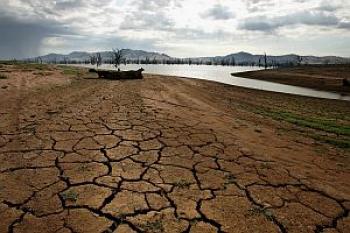The Murray–Darling Basin, Australia’s vast river system is in crisis, with politicians, environmentalists and agricultural producers wrangling over how to address the problem.
The bigger picture, however, holds valuable lessons, says a specialist in water management, and represents an important reality check on the limitations of man’s control of our natural environment.
“It is symbolically enormously important, because I guess the last 150 to 200 years have been dominated by an idea that we can increase our technological control and technological impact,” said Dr Daniel Connell, a specialist in water management in the Murray–Darling Basin at the Australian National University. “Essentially, what we are talking about here is a major retreat.”
Dr Daniel said a process of over-commitment of water allocations in the Murray–Darling system had coincided with a climate shift resulting in a halving of the amount of water available.
“You have two lines in the grass going in different directions and eventually you have a society caught with a whole lot of demands that can’t be met, and conflict about where to go from here,” he told The Epoch Times.
The Murray–Darling Basin provides water to Australia’s “food bowl”, a vast expanse of land running from Queensland down through the two other eastern states to South Australia.
After seven years of drought combined with increasing agricultural development, the Murray River has fallen to 50 per cent below sea level.
Swathes of the riverbed are now exposed, producing a toxic chemical reaction resulting in the generation of sulphuric acid.
“Seventy per cent of red gums along the Murray are dead or dying. Fish species in the Coorong are vanishing before our eyes. This is catastrophic stuff,” said South Australian Greens Senator Sarah Hanson-Young.
Senator Hanson-Young wants more water to be released from lakes further up the river system, but political wrangling between the states has caused an impasse.
“The water is there, but evidently the political will to fix this disastrous situation isn’t,” she said.
Over 5000 people turned up at a rally around the Goolwa freshwater lakes in South Australia last weekend, calling for more water to be released upstream while booing Federal Water Minister Penny Wong.
A South Australian senator, Penny Wong has dismissed calls for more fresh water from upstream saying dwindling supplies were needed for essential human demands and the lakes may be beyond salvation.
Another controversial option has now been mooted by Australia’s most famous climate change commentator Professor Tim Flannery. He is suggesting breaking down the barrages at the mouth of the Murray, allowing sea water to flood the area. Environmentalists, however, are opposing the plan saying the salt water would alter the eco-system beyond recognition.
Dr Connell agrees, saying it would establish a new marine saltwater dominated system. “That would take a number of years and it means the end of the existing environmental system based on fresh water,” he said.
The Coorong Wetlands are internationally recognised and are home to a wide range of migratory birds.
Dr Connell said the ideal situation would be to open Lake Menindee in New South Wales as that had ample water to wash through the area. However, he said that he “couldn’t see that happening” because of the politics involved.
The Murray River, he said, was iconic in Australian culture, but it also represented a turning point in understanding how we interact with our environment.
“The big picture is how aggressive can we be in our impacts on natural systems,” he explained, “how much do we need to take into account what is required to keep them operating as an ecological system.
“This is a very big example of what is really a fairly general problem.”









Friends Read Free